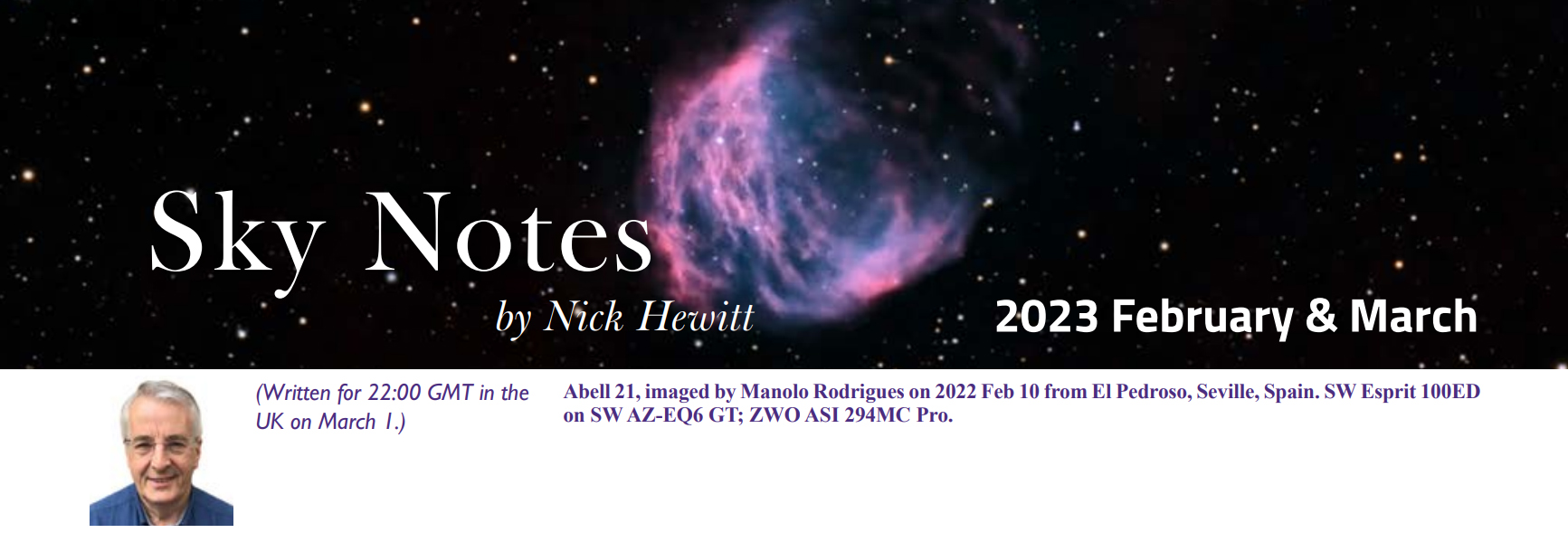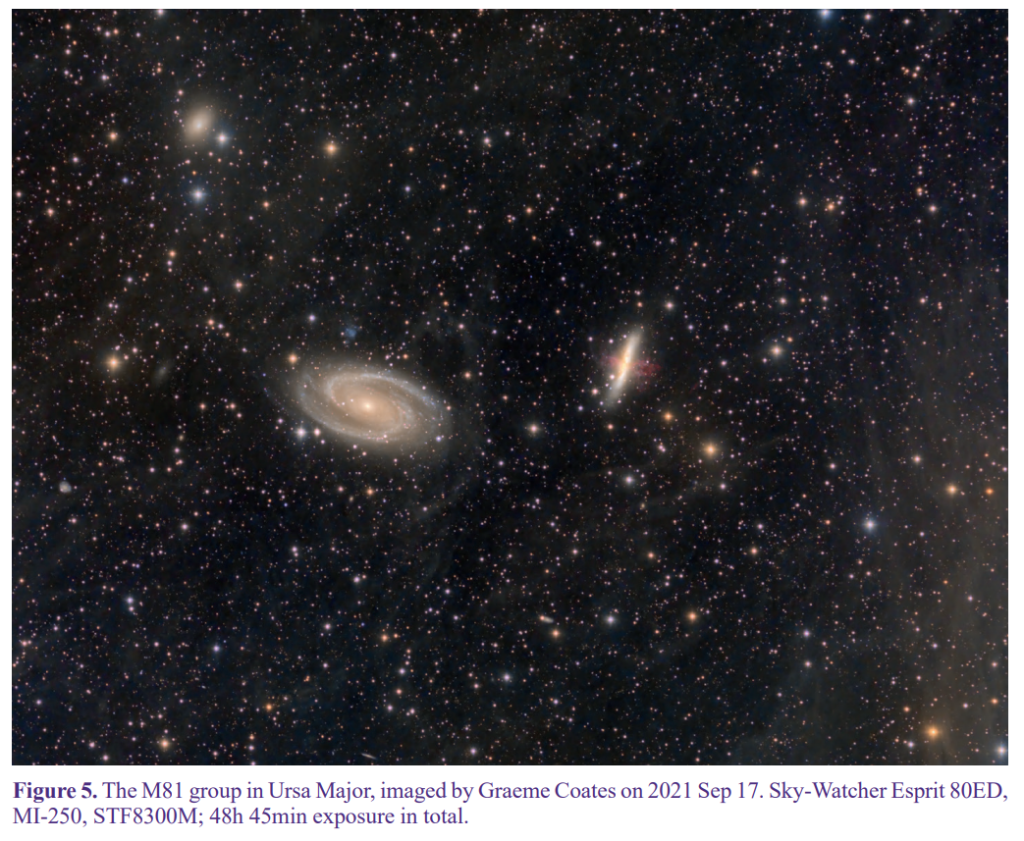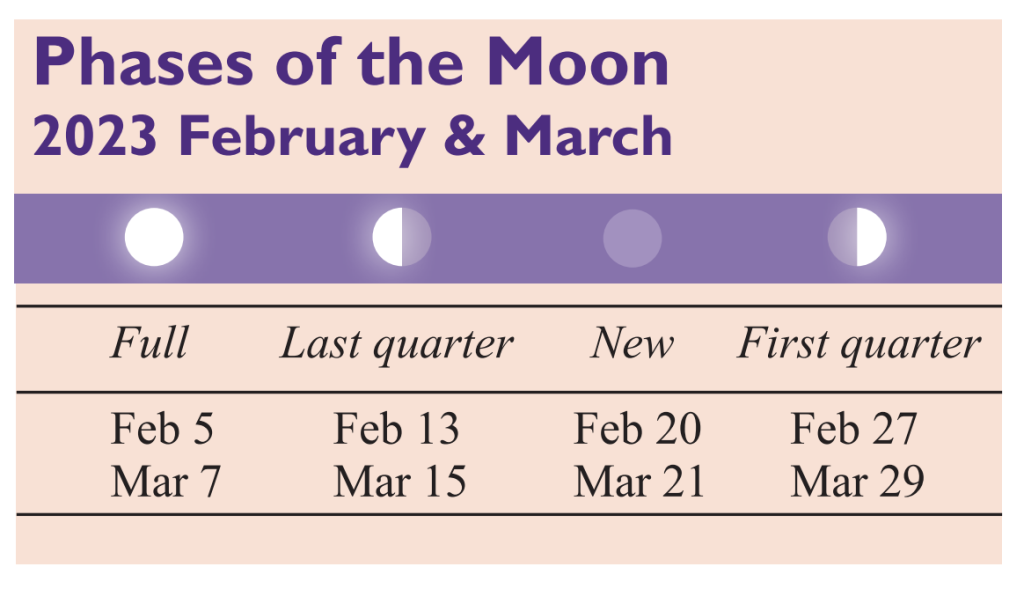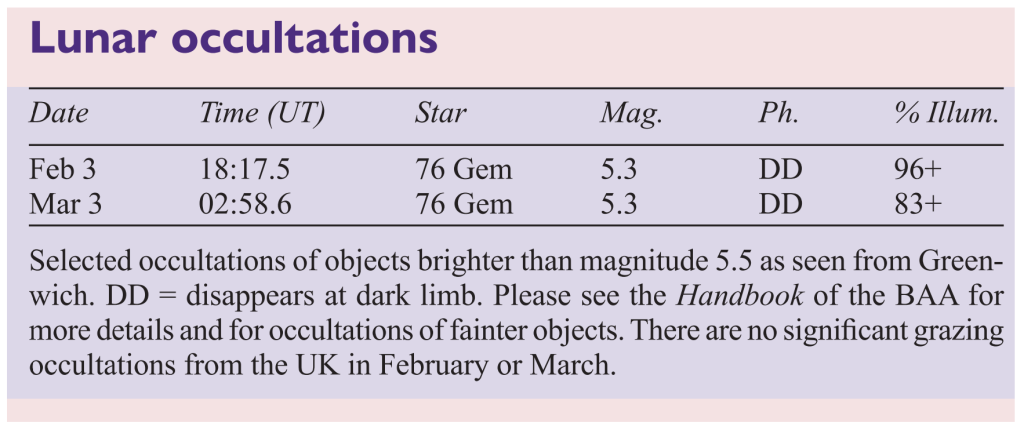Sky notes for 2023 February & March
2023 February 1

The winter days draw out slowly and reach the vernal equinox on Mar 20, followed by the arrival of British Summer Time on Mar 26. After such a feast of planets through the autumn and Christmas, things slowly deteriorate for enthusiasts of the solar system, but of course the deep sky in all its winter glory remains.
By early February, Orion bestrides the meridian like the colossus he is, his belt stars guiding us around the late-winter sky. To the north-west is Taurus, still hosting Mars. The Red Planet lies north of Aldebaran and begins the period a magnitude brighter, but as Mars resumes its easterly progress, they are more of a match in March. To the south-east glitters Sirius, the brightest of all stars due to its relative proximity at 8 light-years. Taking a line from Rigel in the lower right through Betelgeuse at upper left, we find the heavenly twins, Castor and Pollux. Their stars stream towards the hunter and many fine sights abound.

Amongst these are three contrasting planetary nebulae. The best known is NGC 2392, formerly known as the Eskimo Nebula due to its resemblance to a furry parka surrounding a chilly face, but now quite often described as the ‘Clown Face’ or even the ‘Lion’ nebula, the parka transmuting into a mane. It is bright and rewarding, with an unusually bright central star surrounded by a complex inner ring and fuzzy outer haze. Located on the Pollux stream of stars just south-east of 3rd-magnitude double star delta Geminorum (Wasat) with its 8th-magnitude orange companion, the planetary shows a high-surface-brightness, 9th-magnitude, round greenish disc that is 48 × 48 arcseconds in size. It was the first target of the repaired Hubble Space Telescope in 1999 December. We are looking down a cylindrical nebula directly to the pole of the central star, hence its brightness. Visually, it takes magnification well and on the best nights shows rewarding detail. Back in 1930, Clyde Tombaugh located Pluto only half a degree from it.

Just south-west of the multiple star Castor (alpha Geminorum) and north of iota Geminorum lurks a more challenging planetary: NGC 2371–2. This is fainter by a magnitude and a little smaller compared with the Eskimo, but is fun. As hinted by its two NGC numbers, it is bilobed, the south-western component being NGC 2371 and the north-eastern NGC 2372. With its outer extensions, some feel that it resembles Darth Vader’s TIE fighter from Star Wars, but it is usually nicknamed the ‘Double Bubble’. As with NGC 2392, the central star is prominent although quite faint at 14th magnitude; the nebula itself is well served by using an oxygen filter.
The third planetary nebula challenge within Gemini is the Medusa Nebula (Abell 21 or PK205+14.1). This unusually shaped planetary is best located by finding the moderately bright open cluster NGC 2395 to its north-west. The Medusa is a swirl of faint arcs in a crescent of nebulosity. It is large, being over 10 arcminutes across, which dilutes its deceptively 10th-magnitude light. It really requires large aperture, a perfectly dark sky and an oxygen filter for success.

South of Gemini and bypassing the surprisingly barren Canis Minor are the rich fields of Monoceros, the unicorn, boasting two open clusters with nebulosity – NGC 2264 (the Christmas Tree and Cone) and NGC 2244 (the Rosette Nebula) – and numerous easy open clusters. The Christmas Tree cluster and nebulous complex is extraordinary, with the cluster embedded in a ‘fox fur’ wrap with dark nebulae silhouetted against emission adding to the drama. The best known of these molecular clouds is the Cone Nebula at the apex of the Christmas tree – a dark angel indeed. From Betelgeuse, sweep 13° east and a little north to easily locate the cluster in your finder, with the 4th-magnitude variable star S Monocerotis the most prominent.

These favourite targets can detract from other enjoyable sights nearby. Among these is the pretty complex around NGC 2245, a reflection nebula a little to the west of the Christmas Tree. Another reflection nebula, NGC 2247, lies nearby, with faint H-alpha emission and dark nebulae completing the attractive scene.
Exploring further east along the ecliptic from Gemini, we slip south-east through Cancer with its splendid clusters Messier 44 and Messier 67 and into the realm of the early spring galaxies in Leo. The great Virgo–Coma cluster is still low mid-evening in early March but is superb in the late evening at the end of the month and into April.
Ursa Major sprawls high in the north-east throughout February and March; Canes Venatici and Coma Berenices lurk under the rather exaggerated tail, with many fine galaxy groups on display. These groups are usually closer to us than the Virgo–Coma Cluster (65 million light-years distant), affording a better view of their members.

Leo approaches the meridian mid-evening in late March. Its famous Leo Triplet of Messiers 65 and 66 with NGC 3628 is much imaged, but other groups are splendid too. West of the Triplet is the Messier 95 group, consisting of M95, M96, M105 and its fainter companions NGCs 3384 and 3389. This group is some 32 million light-years away and is a mix of spirals and ellipticals. Much further north, in the west of Ursa Major, is an even closer gathering to us: the M81 group. Thought to be some 12 million light-years away, it offers spectacular views of a ‘grand spiral’ galaxy (M81, ‘Bode’s galaxy’), the best irregular galaxy in the northern hemisphere (M82, ‘the Cigar’), plus NGC 3077, an atypical elliptical disrupted by tidal interaction with the more massive M81.
Solar system
There are no solar or lunar eclipses in this time period.
The Sun remains patchily active, with reasonable sunspot and auroral activity. It hopefully will remain so as it climbs higher.

Mercury has just passed western elongation on Jan 30 and appears in the morning sky in Sagittarius – very low from the UK, but at a good altitude from the southern hemisphere. It reaches superior conjunction on Mar 17.
Venus becomes increasingly bright and prominent in the evening sky at magnitude –4 and has a close conjunction with Jupiter on Mar 1.

Mars resumes its motion eastwards in Taurus, now markedly fading from magnitude –0.3 to +0.9 by the end of March. The disc diminishes from 10.8 to 6.4ʺ over the same period, dipping below the 7ʺ threshold for most observers, although the experts will continue to image until the planet is lost in the gloaming at the end of April when in Gemini.
Jupiter remains bright in Pisces but is getting low in the west by early evening. There is a remarkably close conjunction with Venus on Mar 1, when the two brightest planets are a mere 40 arcminutes apart. By the end of March, it is lost prior to conjunction with the Sun on Apr 11.
Saturn is in conjunction with the Sun on Feb 16 and eventually emerges into the morning sky, but too low down for observation.
Uranus is still well placed in early evening, in Aries. Venus passes to the north of the ice giant on Mar 31.
Neptune is at conjunction on Mar 16 so will be lost, although on Feb 15 it is a mere 16 arcminutes from Venus. The magnitude difference will be striking!
Two of the larger minor objects of the Sun’s family are at opposition in March. Both are dwarf planets. By far the easier of these is Ceres; this brightest dwarf planet is at opposition in Leo on Mar 21 and is magnitude 7. It is followed by trans-Neptunian Makemake on Mar 30, when in Coma Berenices at magnitude 17.
Comets
Comet C/2022 E3 (ZTF) should be the cometary highlight in February, presuming its brightening progresses as predicted and observed at the time of writing. It is closest to Earth on Feb 1 when 42.5 million kilometres from us. Having been tucked up in Corona Borealis over the Christmas period, it will have accelerated into a circumpolar position and continues to dash across the circumpolar sky from Camelopardalis through Auriga in early February, into Taurus by mid-month and Orion by the end. It is hoped that it will reach 5th magnitude and so be a binocular object.
Also on Feb 1, periodic comet 263P/Gibbs is at perihelion. It should be at magnitude 8 in Coma Berenices, within the Coma star cluster (Melotte 111).
29P/Schwassmann–Wachmann 1 is well placed on the Auriga/Gemini border, generally faint but prone to outburst, so worth monitoring.
Meteors
This is a poor season for meteors, there being no major showers during February or March. Two minor showers may be observed, although the Delta Leonids, derived from Comet 55P/Tempel–Tuttle, will be at their maximum on Feb 25. The Pi Virginids, although weak, peak during the first week of March.
| The British Astronomical Association supports amateur astronomers around the UK and the rest of the world. Find out more about the BAA or join us. |
